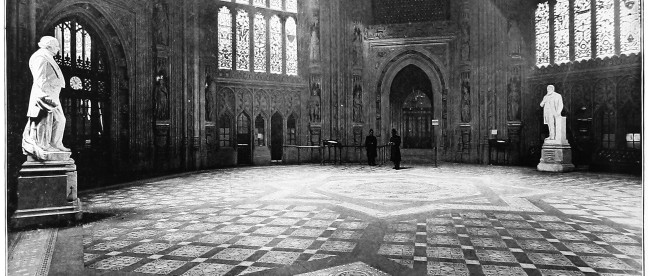The Gallery Today

When the authorities began to plan reconstruction after the war, the Press Gallery asked for more seats, more office space, better telephones and even a smarter entrance.
To its surprise it got what it asked for.
When the new chamber opened in October 1950, even the acoustics were better. MPs had agreed to introduce microphones linked to speakers in the gallery.Reporters no longer struggled to hear what was being said on the floor below.
Giles Gilbert Scott, who redesigned the Chamber, provided reporters with rows of elegant wooden telephone cubicles.
The resolution barring reporting as a “breach of privilege” remained in force (only in 1971 did the House agree to allow its proceedings to be reported without risk).
Winston Churchill spotted how things would change. In a speech to the Press Gallery in April 1945 he predicted: “The long fight which the House had against being reported is succeeded by the long fight which it is having and going to have over being reported at all.”
Asked for his opinion on the relations between Commons and Fourth Estate in 1963 Sir Barnett Cocks, the Clerk of the House, summed it up: “The press, constitutionally and historically, is here on sufferance. That is the position. Whatever recognition you have, on a lobby basis and so on, seems to be grudgingly given on pain of cancellation should the press once step out of line.”
It didn’t have to be that way. “At present you are tolerated but not respected which I think you ought to be as members of a great profession. You ought not to be treated as slightly suspect characters sitting up in the gallery.”
By the early 1990s the effects of competition, television, the rise of lobby journalism and changing public taste had forced newspapers to abandon gallery reporting. A decade later parliamentary pages had made a comeback, as “spin” in turn fell out of fashion.
About 170 journalists work in the Press Gallery each day, less than the post-war peak. Computers have replaced typewriters but Dickens would recognise the cramped and chaotic conditions. The upper gallery corridor’s warren of offices – the rooms, with fireplaces, had once been part of the Commons Librarian’s house – is affectionately known in the Palace as the “Burma Road”.
Shared experience of the war could not disguise the unresolved tensions between Press Gallery and Parliament. The MP who complained in 1738 about “fellows who thrust themselves into our gallery” would have been at home among his 20th century colleagues.
The Press Gallery of 2024 is more than its name suggests: it is also a broadcasters’ gallery, an Internet gallery, an agency gallery, a magazine gallery, its members producing an extraordinary range of political and policy coverage far more informative than what their forebears produced a century ago.
